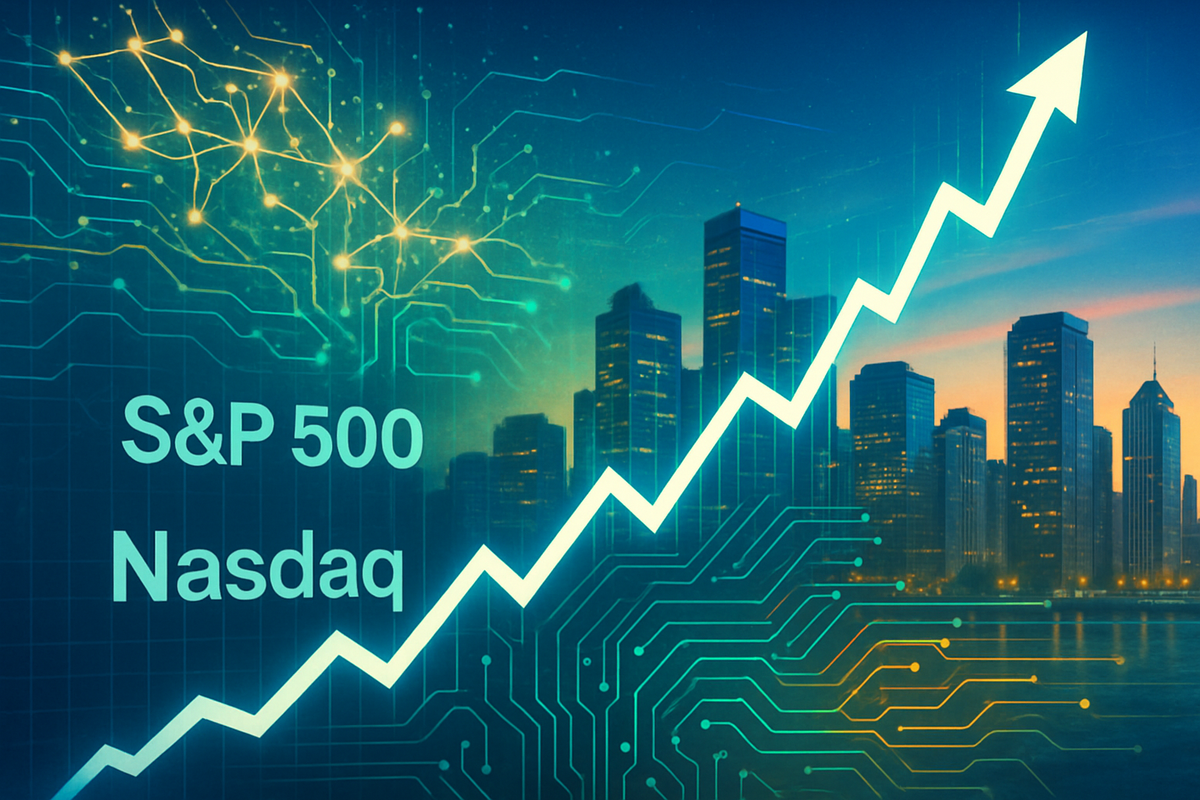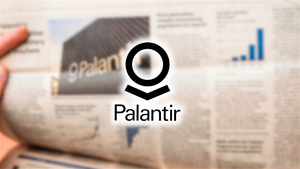
The U.S. stock market achieved a significant milestone on Wednesday, October 8, 2025, as both the S&P 500 and Nasdaq Composite indices surged to fresh all-time record highs. This remarkable rally, occurring despite an ongoing U.S. government shutdown, underscores a powerful wave of investor optimism fueled by expectations of a more accommodative Federal Reserve and the relentless momentum of technological innovation, particularly in artificial intelligence. The immediate implications point to a robust, albeit potentially overheated, market environment where confidence in corporate earnings and future growth prospects remains exceptionally strong.
This latest surge signals a resilient financial landscape that appears largely unfazed by political headwinds, instead focusing on fundamental economic drivers and technological advancements. As of Thursday, October 9, 2025, investors are pausing to digest these gains, with futures for both benchmarks showing minimal change in early trading. The record-breaking performance has ignited discussions about market sustainability, valuation levels, and the potential for a continued bull run, setting a vibrant tone for the remainder of the year.
Record-Setting Performance Driven by Optimism and Innovation
On Wednesday, October 8, 2025, the market witnessed a historic session that propelled major indices into uncharted territory. The S&P 500 closed at an unprecedented 6,753.72, marking a gain of 0.58% for the day, after touching an intraday high of 6,760.89. In parallel, the technology-heavy Nasdaq Composite surged by 1.12% to close at a record 23,043.38, breaching the 23,000 level for the first time in its history. The Nasdaq 100 also posted a significant climb of 1.2%. These record closes reflect a confluence of factors that have bolstered investor confidence over recent weeks.
A primary catalyst for this rally has been the growing anticipation of further interest rate cuts by the Federal Reserve. Minutes from the Fed's September meeting, released recently, indicated a strong consensus among policymakers for an accommodative monetary stance in 2025, with markets now pricing in a high probability (around 95%) of an October rate cut. This dovish pivot is seen as highly supportive of economic growth and risk-taking, making equities an attractive asset class. Simultaneously, the relentless march of technological innovation, particularly in the artificial intelligence sector, has provided a powerful tailwind. Companies like Nvidia (NASDAQ: NVDA) and Advanced Micro Devices (NASDAQ: AMD) have been at the forefront of this AI-driven momentum, consistently pushing market valuations higher.
Initial market reactions have been overwhelmingly positive, characterized by elevated investor confidence and a palpable "wealth effect." However, some analysts are beginning to sound notes of caution regarding potential overvaluations. Momentum indicators, such as the Relative Strength Index (RSI), are reportedly flashing "overbought" signals across various timeframes, suggesting that a period of consolidation or a minor pullback might be on the horizon. Despite these warnings, the market's focus remains squarely on the robust third-quarter corporate earnings season, with early positive reports from bellwethers like Delta Air Lines (NYSE: DAL) and PepsiCo (NASDAQ: PEP) further fueling the optimistic sentiment.
Potential Winners and Losers in the Current Market Surge
The current market environment, characterized by record highs in the S&P 500 and Nasdaq, presents clear beneficiaries and potential challenges for various companies and sectors. Technology and growth-oriented companies, particularly those at the forefront of artificial intelligence and digital transformation, are undoubtedly the biggest winners. The Nasdaq's surge above 23,000 is a testament to the continued dominance of mega-cap tech giants. Companies like Nvidia (NASDAQ: NVDA), which designs and manufactures graphics processing units (GPUs) crucial for AI, and Advanced Micro Devices (NASDAQ: AMD), another key player in high-performance computing, are direct beneficiaries. Their robust growth trajectories and pivotal roles in the AI revolution have made them market darlings, driving significant portions of the recent gains. Software-as-a-Service (SaaS) providers, cloud computing companies, and cybersecurity firms also stand to gain as businesses continue to invest heavily in digital infrastructure.
Beyond technology, sectors traditionally sensitive to economic growth and consumer spending are also performing well. The expectation of Federal Reserve rate cuts tends to stimulate borrowing and investment, which can benefit financial institutions, albeit with potentially tighter net interest margins. Consumer discretionary companies, such as e-commerce giants and luxury brands, could see increased demand due to the "wealth effect" from rising stock portfolios. Early positive earnings reports from companies like Delta Air Lines (NYSE: DAL) suggest a healthy travel and leisure sector, while consumer staples like PepsiCo (NASDAQ: PEP) demonstrate resilience and consistent demand even in dynamic market conditions.
Conversely, companies that might face headwinds include those with high debt loads, especially if interest rates do not fall as rapidly or as much as currently anticipated, or if economic growth falters unexpectedly. Value stocks, which have lagged growth stocks for an extended period, might continue to underperform if the current market sentiment persists, favoring high-growth narratives. Additionally, companies heavily reliant on traditional, non-tech-driven business models might find it challenging to compete for investor attention and capital against the backdrop of the AI boom. While the overall market is up, a rising tide does not lift all boats equally, and companies with less compelling growth stories or those facing structural industry challenges could see their relative valuations decline.
Wider Significance: A New Era Shaped by AI and Monetary Policy
The unprecedented ascent of the S&P 500 and Nasdaq to record highs on October 8, 2025, signifies a profound shift in the broader financial landscape, largely dictated by the transformative power of Artificial Intelligence and strategic monetary policy. This event is not merely a fleeting market high but rather a reflection of deep-seated industry trends. The AI boom has firmly established itself as the preeminent growth driver, creating entirely new paradigms in demand for advanced semiconductors and expansive cloud computing infrastructure. Companies like Nvidia (NASDAQ: NVDA), Advanced Micro Devices (NASDAQ: AMD), and Dell Technologies (NYSE: DELL) are at the vanguard, their valuations swelling due to robust AI-related deals and the insatiable demand for AI infrastructure. This relentless pursuit of AI capabilities is fostering innovation across diverse sectors, compelling companies from finance to manufacturing to integrate AI to maintain competitiveness, thereby creating a bifurcated market where AI-forward firms thrive and laggards face immense pressure.
The ripple effects of this AI-driven surge are extensive. Companies leading in AI development and infrastructure, such as chip manufacturers and cloud service providers, are experiencing unprecedented revenue growth and increased valuations. Strategic partnerships, exemplified by AMD's multi-year agreement with OpenAI, are proving to be game-changers, solidifying market positions and opening substantial revenue streams. Conversely, competitors with limited AI exposure or those perceived as slow in innovation face significant challenges, as capital is reallocated towards more promising, AI-focused entities. This dynamic is also reshaping Mergers and Acquisitions (M&A) activity, with strategic buyers and private equity firms increasingly targeting resilient, high-growth businesses where AI and automation are essential for operational efficiency and future valuations. The sustained rally, fueled by technological innovation and an accommodative monetary policy, is fostering a "wealth effect" that encourages capital inflows, yet also prompts a growing search for value in overlooked small-cap stocks as market capitalization concentrates in a few mega-cap AI stocks.
From a regulatory and policy standpoint, the current market dynamics present several critical considerations. The Federal Reserve's anticipated interest rate cuts, with the September FOMC minutes indicating a consensus for additional 25 basis-point cuts by the end of 2025, are a crucial factor supporting the market rally. This dovish stance, aimed at supporting employment amidst a potentially weakening labor market, is boosting investor confidence, though some analysts caution that financial markets might be too aggressive in pricing in future cuts. Concurrently, the accelerating pace of AI development is intensifying calls for increased regulation globally, with AI governance becoming a pivotal feature of the compliance agenda. Furthermore, concerns have been raised by the Bank of England regarding challenges to the U.S. Federal Reserve's independence, particularly from political interference, which could lead to significant market volatility. The current administration's expected deregulatory agenda in capital markets, potentially impacting areas like ESG/climate risk regulations and bank capital rules, could also create regulatory divergence and complexity for global firms. Adding another layer of complexity, new U.S. tariff hikes introduced in January 2025 are already contributing to market volatility, particularly in trade-sensitive sectors, and are expected to exert upward pressure on import prices and inflation.
Historically, the current market environment draws intriguing comparisons. The Bank of England has explicitly warned that the "stretched" valuations for AI companies currently rival those seen during the dot-com bubble of the late 1990s, which ultimately ended in a spectacular crash. While many argue that today's AI leaders are backed by significant profit growth, the risk of a "sharp market correction" exists if expectations around AI's impact become less optimistic or if material bottlenecks (e.g., in power, data supply chains) arise. The high concentration of market capitalization in a few mega-cap AI stocks further exacerbates these concerns. Interestingly, the S&P 500's resilience amidst the ongoing U.S. government shutdown is consistent with historical patterns, suggesting investors tend to view these events as temporary political noise rather than fundamental economic threats. The rally, partly fueled by anticipated interest rate cuts, also aligns with historical instances where dovish monetary policy signals have been growth-friendly for equities. However, strategists caution that a significant amount of "good news" regarding potential rate cuts may already be priced into valuations, suggesting limited upside if economic data or earnings growth does not continue to support the current optimism. The market, therefore, appears to be walking a "tightrope" between the AI boom and potential macroeconomic headwinds.
What Comes Next: Navigating the Path Ahead
As the S&P 500 and Nasdaq bask in the glow of record highs on October 9, 2025, the crucial question for investors and market participants is: what comes next? The path forward is marked by a blend of significant opportunities and notable challenges, demanding strategic adaptation. In the short term (Q4 2025 - early 2026), analysts generally anticipate continued, albeit potentially more moderate, growth. The expectation of further interest rate cuts by the Federal Reserve remains a significant tailwind, with a high probability of an October cut and potentially two more before year-end. However, technical indicators, such as the Relative Strength Index (RSI) across multiple timeframes, are flashing "overbought" signals for the S&P 500, suggesting a potential for a healthy pullback or sideways consolidation as the market digests its recent gains. The ongoing U.S. government shutdown, by limiting the release of key economic data, has also shifted investor focus squarely onto the upcoming third-quarter earnings season for validation of the current AI-driven rally.
Looking further out into 2026 and beyond, the long-term possibilities suggest a potentially broadening bull market. There are signs that the rally, which began in October 2022, is extending beyond just the "Magnificent 7" tech giants, with small-cap stocks, cyclical sectors, and even healthcare beginning to participate. This broadening suggests a deeper and potentially more sustainable foundation for growth. Some Wall Street firms have raised their year-end forecasts, with targets for the S&P 500 ranging from 7,000 by the end of 2025 to 7,750 next year. There's even a 30% probability of a "bubble scenario" pushing the index past 9,000, particularly if the sustained demand for AI infrastructure, exemplified by multi-year revenue roadmaps from companies like Oracle (NYSE: ORCL), continues unabated.
For investors, the current environment necessitates careful strategic pivots. Diversification into uncorrelated assets such as infrastructure, hedged equity, and real assets may offer better risk-adjusted returns given elevated valuations and concentration risk in mega-cap tech. Rebalancing portfolios and selectively deploying cash can enhance outcomes, while for those not fully invested, patience to "buy the dip" during potential pullbacks could prove effective. A continued focus on company fundamentals will be crucial during earnings season to ascertain if AI-fueled valuations are justified by genuine profit growth. Companies, particularly in the technology sector, must maintain their aggressive focus on AI-related research, development, and infrastructure buildout to meet market expectations and sustain growth. Market opportunities abound in the AI ecosystem, including companies like Broadcom (NASDAQ: AVGO) and Palantir Technologies (NYSE: PLTR), as well as in the broader market segments and potentially undervalued value stocks. However, challenges persist, including concerns about an "AI bubble," the risk of a significant correction if it bursts, unexpected shifts in interest rate policy, a prolonged government shutdown, and broader macroeconomic headwinds like a weakening labor market or geopolitical instability. The market is navigating a complex landscape, balancing the immense potential of AI with inherent economic and geopolitical uncertainties.
Comprehensive Wrap-up: A Market at a Crossroads
The S&P 500 and Nasdaq's ascent to fresh record highs on October 8, 2025, marks a pivotal moment, encapsulating a period of robust corporate performance, an anticipated dovish shift from the Federal Reserve, and the undeniable force of the Artificial Intelligence revolution. Key takeaways from this event underscore a market driven by strong earnings, particularly from the tech sector, an optimistic economic outlook despite political uncertainties, and investor confidence buoyed by expectations of lower interest rates. The "Everything rally," where both risk assets like stocks and safe havens such as gold are simultaneously reaching new peaks, highlights a complex market dynamic fueled by substantial global liquidity and a blend of growth optimism and underlying anxieties.
Moving forward, the market faces a nuanced assessment. While the momentum is strong, concerns regarding elevated valuations, particularly in AI-focused technology companies, persist. The sustainability of corporate earnings growth will be paramount, requiring careful scrutiny during upcoming reporting seasons. The Federal Reserve's monetary policy path remains a critical determinant; while rate cuts are widely expected, any unexpected hawkish shifts could temper enthusiasm. Geopolitical stability, the impact of the ongoing U.S. government shutdown, and the potential for a broader economic slowdown—especially if the labor market deteriorates—are all significant factors that could introduce volatility. The market appears to be walking a tightrope, balancing the immense potential of AI with inherent macroeconomic and geopolitical uncertainties.
The significance of these record highs extends beyond mere numbers; they reflect a resilient economy (or at least, a perceived one) and a corporate landscape rapidly adapting to technological advancements. The "wealth effect" generated by rising asset values could further stimulate consumer spending, providing a psychological boost to the broader economy. This period could serve as confirmation of a long-term growth trend, albeit one punctuated by inevitable corrections. However, the concentration of market capitalization in a few mega-cap AI stocks raises questions about the overall market breadth and potential fragility.
In the coming months, investors should vigilantly watch several key indicators. Continued strong corporate earnings reports and optimistic forward guidance will be crucial. Inflation data, including CPI and PCE, will dictate the Federal Reserve's future interest rate decisions. Broader economic indicators like GDP growth, unemployment rates, and consumer spending trends will provide insights into underlying economic health. Geopolitical developments, particularly those impacting global supply chains or trade, could introduce unexpected volatility. Finally, monitoring the market's breadth—whether the rally continues to broaden beyond a few tech giants to include small-cap and value stocks—will be essential for assessing the health and sustainability of this record-setting bull run.
This content is intended for informational purposes only and is not financial advice





